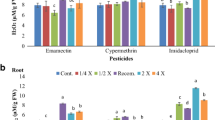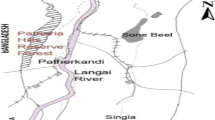Abstract
Pesticides are highly toxic substances. Their toxicity may not be absolutely specific to the target organisms but can adversely affect different processes in the non-target host plants. In the present study, the effect of over application of four commonly used pesticides (emamectin benzoate, alpha-cypermethrin, lambda-cyhalothrin and imidacloprid) was evaluated on the germination, seedling vigor and photosynthetic pigments in tomato. The obtained results revealed that seed germination was decreased by the pesticides and this effect was more prominent at early stages of exposure. All the tested pesticides reduced the growth of tomato when applied in higher concentration than the recommended dose, but at lower doses the pesticides had some stimulatory effects on growth as compared to the control. A similar effect of pesticides was observed on the photosynthetic pigments, i.e. a decrease in pigments concentrations was caused at higher doses but an increase was observed at lower doses of pesticides. The calculation of EC50 values for different parameters revealed the lowest EC50 values for emamectin (ranged as 51–181 mg/L) followed by alpha-cypermethrin (191.74–374.39), lambda-cyhalothrin (102.43–354.28) and imidacloprid (430.29–1979.66 mg/L). A comparison of the obtained EC50 values for different parameters of tomato with the recommended doses revealed that over application of these pesticides can be harmful to tomato crop. In a few cases these pesticides were found toxic even at the recommended doses. However, a field based study in this regard should be conducted to further verify these results.







Similar content being viewed by others
References
Ahmed AM, Heikal MD, Hindawy OS (1983) Side effects of benomyl (Fungicide) treatments on sunflower, cotton and cowpea plants. Phyton 23:185–195
Akhtar MW, Sengupta D, Chowdhury A (2009) Impact of pesticides use in agriculture: their benefits and hazards. Interdisc Toxicol 2:1–12
Akobundu (1987) Safe use of herbicides. Weed science in the tropics: principles and practices. Wiley, New York, pp 318–334
Aksoy O, Deveci A, Kizilirmak S, Akdeniz GB (2013) Phytotoxic effect of quizalofop-P-ethyl on soybean (Glycine max L.). J Biol Environ Sci 7:49–55
Ashraf M, Harris PJC (2013) Photosynthesis under stressful environments: an overview. Photosynthetica 51:163–190
Asogwa EU, Dongo LN (2009) Problems associated with pesticide usage and application in Nigerian cocoa production: a review. Afr J Agric Res 4:675–683
Azizullah A, Richter P, Häder DP (2011) Comparative toxicity of the pesticides carbofuran and malathion to the freshwater flagellate Euglena gracilis. Ecotoxicology 20:1442–1454
Baig SA, Akhter NA, Ashfaq M, Asi MR, Ashfaq U (2012) Imidacloprid residues in vegetables, soil and water in the southern Punjab, Pakistan. J Agric Technol 8:903–916
Bibi A, Sadaqat HA, Tahir MHN, Akram HM (2012) Screening of sorghum (Sorghum bicolor var Moench) for drought tolerance at seedling stage in polyethylene glycol. J Anim Plant Sci 22:671–678
Cali IO, Candan F (2009) The effect of fungicide application on pollen structure in tomato (Lycopersicon esculentum Mill.) plant. J Appl Biol Sci 3:37–40
Cardone A (2015) Imidacloprid induces morphological and molecular damages on testis of lizard (Podarcis sicula). Ecotoxicology. doi:10.1007/s10646-014-1361-0
Carvalho FP (2006) Agriculture, pesticides, food security and food safety. Environ Sci Policy 9:68–692
CEPIS/PAHO (2005) Pan-American center for sanitary engineering and environmental Sciences. Self taught course on diagnosis, treatment and prevention of acute pesticide poisoning
Chahid K, Laglaoui A, Zentar S, Ennabili A (2013) Effect of alpha-cypremethrin on morphological parameters in tomato plants (Lycopersicon esculentum Mill.). Am J Environ Prot 2:149–153
Chauhan SS, Agrawal S, Srivastava A (2013) Effect of imidacloprid insecticide residue on biochemical parameters in potatoes and its estimation by HPLC. Asian J Pharma Clin Res 6:114–117
Chohan TZ, Ahmad S (2008) An assessment of tomato production practices in Danna Katchely, Azad Jammu Kashmir. Pak J Life Soc Sci 6:96–102
Coskun Y, Kilic S, Duran RE (2015) The effects of the insecticide pyriproxyfen on germination, development and growth responses of maize seedlings. Fresenius Environ Bull 24:278–284
DeLorenzo ME, Scott GI, Ross PE (2001) Toxicity of pesticides to aquatic microorganisms: a review. Environ Toxicol Chem 20:84–98
Dobsikova R (2003) Acute toxicity of carbofuran to selected species of aquatic and terrestrial organisms. Plant Protect Sci 39:103–108
Ecobichon DJ (2001) Pesticide use in developing countries. Toxicology 160:27–33
Edwards CA (1986) Agrochemicals as environmental pollutants. In: Van Hofsten B, Eckstrom G (eds) Control of pesticide applications and residues in food. A guide and directory. Swedish Science Press, Uppsala
FAO (2007) Food and Agricultural Organization Stat, core production 2005. http://faostat.fao.org/site/340/default.aspx
Garcia PC, Rivero RM, Ruiz JM, Romero L (2003) The role of fungicides in the physiology of higher plants: implications for defense responses. Bot Rev 69:162–172
Glover-Amengor M, Tetteh FM (2008) Effect of pesticide application rate on yield of vegetables and soil microbial communities. W Afr J Appl Eco 12:1–7
Haq QU, Ali T, Ahmad M, Nosheen F (2008) An analysis of pesticide usage by cotton growers: a case study of district Multan, Punjab-Pakistan. Pak J Agric Sci 45:133–137
Idrovo A (2000) Surveillance of pesticide poisonings in Colombia. Public health 2:36–46
Khan AF (2004) Hazards of pesticide spray on vegetables. The Daily Dawn Pakistan, Internet Edition, June 12
Khan MS, Shah MM, Mahmood Q, Hassan A, Akbar K (2011) Assessment of pesticide residues on selected vegetables of Pakistan. J Chem Soc Pak 33:816–821
Khan BA, Zubair A, Khan SA, Ud-Din Z (2012) Monitoring pesticide residues in fruits and vegetables grown in Khyber Pakhtoonkhwa. Int J Green Herb Chem 1:302–313
Khokhar KM (2013) Present status and prospects of tomatoes in Pakistan. http://www.agricorner.com/present-status-and-prospects-of-tomatoes-in-pakistan/
Khooharo AA, Memon RA, Mallah MU (2008) An empirical analysis of pesticide marketing in Pakistan. Pak Eco Soc Rev 46:57–74
Kilic A, Duran RE, Coskun Y (2015) Morphological and physiological responses of maize (Zea mays L.) seeds grown under increasing concentrations of chlorantraniliprole insecticides. Pol J Environ Stud 3:1069–1075
Krishnasamy V, Pandian IRS (1992) Effect of fungicidal seed treatment in Brinjal. South Indian Hortic 40:207–212
Lee-Fook-Choy LH, Seeneevassen S (1998) Monitoring insecticide residues in vegetables and fruits at the market level. AMAS, Food and Agricultural Research Council, Reduit 95
Lichtenthaler HK, Wellburn AR (1983) Determinations of total carotenoids and chlorophylls a and b of leaf extracts in different solvents. Biochem Soc Trans 11:591–592
Luscombe BM, Pallett KE, Loubiere P, Millet JC, Melgarejo J, Vrabel TE (1995) RPA 201772 A novel herbicide for broad leaf and grass weed control in maize and sugar cane. British Crop Protection Council. Brighton Crop Prot Conf Weeds 2:35–42
Maheswari DK, Gupta M, Swahney R, Khandelwal A (1993) Dual behaviour of carbaryl and 2,4-dichlorophenoxyacetic acid in Rhizobium leguminosarum under explanta conditions. Xentrablatt Microbiol 148:588–592
Martinez RS, Di Marzio WD, Saenz ME (2015) Genotoxic effects of commercial formulations of Chlorpyrifos and Tebuconazole on green algae. Ecotoxicology 24:45–54
Mirza I (2007) Tomato paste plant to be set up at Killa Saifullah. http://www.pakissan.com/english/news/newsDetail.php?newsid=15041. Accessed 31 Aug 2007
Misra SG, Mani D (1994) Adverse effects of Pesticides. In: Misra SG, Mani D (eds) Agricultural pollution II. Ashish Publisher, New Delhi
Mitra J, Raghu K (1998) Pesticides non target plants interactions: an overview. Arch Agron Soil Sci 43:445–500
Mitra A, Chatterjee C, Mandal FB (2011) Synthetic chemical pesticides and their effects on birds. Res J Environ Toxicol 5:81–96
Montfort F, Klepper BL, Smiley RW (1996) Effects of two triazole seed-treatments, triticonazole and triadimenol, on growth and development of wheat. Pest Sci 46:315–322
Moore MT, Huggett DB, Huddleston GM, Rodgers JH, Cooper CM (1999) Herbicide effects on Typha latifolia (Linneaus) germination and root and shoot development. Chemosphere 38:3637–3647
Murthy PK, Rao D (1980) Effect of two fungicides on the germination and growth in Brassica nigra Koach. Geobios 7:160–161
Muthuswamy S, Padmanabhan D, Nagarajan R (1983) Efficacy of seed dressing fungicides on the viability of chili seeds. Pesticides 17:23–28
Parween T, Jan S, Fatma T (2011) Alteration in nitrogen metabolism and plant growth during different developmental stages of green gram (Vigna radiata L.) in response to chlorpyrifos. Acta Physiol Plant 33:2321–2328
Picanco M, Leite GL, Guedes RN, Silva EA (1998) Yield loss in trellised tomato affected by insecticidal sprays and plant spacing. Crop Prot 17:447–452
Rachid R, Djebar-Berrebbah H, Djebar MR (2008) Growth, chitin and respiratory metabolism of Tetrahymena pyriformis exposed to the insecticide Novaluron. Am-Eurasian J Agric Environ Sci 3:873–881
Rehman K (1994) Pesticides causing environmental pollution. In: Habib N (ed.) A workshop on people and pesticides. Khoj-Research and Publication Center, Lahore, Pakistan, pp 39–40
Rio AD, Bamberg J, Centeno-Diaz R, Salas A, Roca W, Tay D (2012) Effects of the pesticide furadan on traits associated with reproduction in wild potato species. Am J Plant Sci 3:1608–1612
Saladin G, Magne C, Clement C (2003) Effects of fludioxonil and pyrimethanil, two fungicides used against Botrytis cinerea, on carbohydrate physiology in Vitis vinifera L. Pest Manag Sci 59:1083–1092
Sammaiah D, Shekar ChC, Prasad VR, Reddy JK (2011) Pesticides induced alterations in physiological responses in Solanum melongena L. Int J Pharma Bio Sci 2:374–384
Shakoor A, Sabri MA, Afzal M, Bashir MH (2010) Role of plant morphological characters towards resistance of some cultivars of tomato against phytophagous mites (Acari) under greenhouse conditions. Pak J Life Soc Sci 8:131–136
Shanmugapriya AK, Sivakumar T, Panneerselvam R (2013) Difenoconazole and Tricyclazole induced changes in photosynthetic pigments of Lycopersicon esculentum L. Int J Agric Food Sci 3:72–75
Sheikh SA, Nizamani SM, Panhwar AA, Mirani BN (2013) Monitoring of pesticide residues in vegetables collected from markets of Sindh, Pakistan. Food Sci Technol Lett 4:41
Siddiqui ZS, Ahmed S (2000) Effect of systemic fungicide on nutritive composition of diseased and healthy plant of Triticum aestivum L. Pak J Biol Sci 3:2148–2150
Siddiqui ZS, Ahmed S (2006) Combined effects of pesticide on growth and nutritive composition of soybean plants. Pak J Bot 38:721–733
Siddiqui ZS, Ahmed S, Gulzar S (1997) Effect of topsin-M (methyl-thiophenate) and Bayleton (Triademifon) on seedling growth, biomass, nodulation and phenolic content of Sesbania sesban. Bang J Bot 26:127–130
Spiers JD, Davies FT, Che JR, Heinz KM, Bogran CE, Starman TW (2008) Do insecticides affect plant growth and development? Greenhouse Grower. http://aggie-horticulture.tamu.edu/faculty/davies/research/abstracts/pdfs
Straw NA, Fielding NJ, Waters A (1996) Phytotoxicity of insecticides used to control aphids on Sitka spruce, Picea sitchensis (Bong.) Carr. Crop Prot 15:451–459
Tiyagi SA, Ajaz S, Azam MF (2004) Effect of some pesticides on plant growth, root nodulation and chlorophyll content of chickpea. Arch Agron Soil Sci 50:529–533
Tort N, Oztork I, Guvensen A (2005) Effects of some fungicides on pollen morphology and anatomy of tomato (Lycopersicon esculentum mill.). Pak J Bot 37:23–30
Xia XJ, Huang YY, Wang L, Huang LF, Yu YL, Zhou YH, Yu JK (2006) Pesticides-induced depression of photosynthesis was alleviated by 24-epibrassinolide pretreatment in Cucumis sativus L. Pestic Biochem Physiol 86:42–48
Yardim EN, Edwards CA (2003) Effects of organic and synthetic fertilizer sources on pest and predatory insects associated with tomatoes. Phyto Parasit 4:324–329
Yildiztekin M, Kaya C, Tuna AL, Ashraf M (2015) Oxidative stress and antioxidative mechanisms in tomato (Solanum lycopersicum L.) plants sprayed with different pesticides. Pak J Bot 47:717–721
Zhang WJ, Jiang FB, Ou JF (2011) Global pesticide consumption and pollution: with China as a focus. Proc of the Int Acad Eco Environ Sci 1:125–144
Acknowledgments
The authors are thankful to Kohat University of Science and Technology (KUST), Kohat, Pakistan for supporting this study.
Author information
Authors and Affiliations
Corresponding author
Ethics declarations
Conflict of interest
The authors declare that they have no conflict of interest.
Rights and permissions
About this article
Cite this article
Shakir, S.K., Kanwal, M., Murad, W. et al. Effect of some commonly used pesticides on seed germination, biomass production and photosynthetic pigments in tomato (Lycopersicon esculentum). Ecotoxicology 25, 329–341 (2016). https://doi.org/10.1007/s10646-015-1591-9
Accepted:
Published:
Issue Date:
DOI: https://doi.org/10.1007/s10646-015-1591-9




